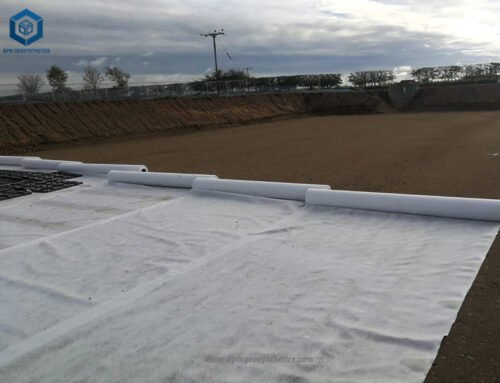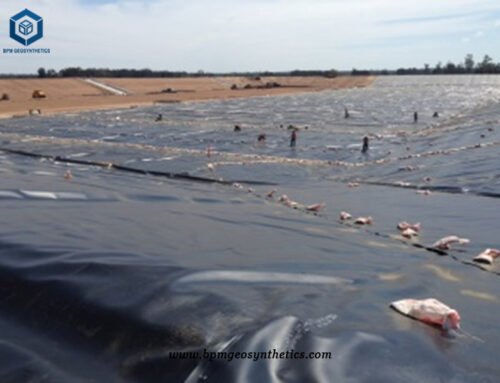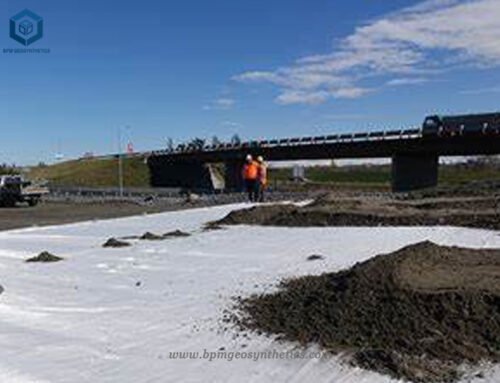Nonwoven PET filament geotextile is indeed a type of geosynthetic material commonly utilized in civil engineering and construction applications. Geotextiles, including nonwoven PET filament geotextiles, are engineered synthetic materials designed to enhance the performance and longevity of various civil engineering projects by providing reinforcement, filtration, separation, and drainage functions.
PET filament geotextiles are manufactured using polyester, which is a type of polymer derived from petroleum. Polyester is a versatile material with excellent physical and mechanical properties, making it suitable for geosynthetic applications. The PET filaments are formed into a nonwoven structure through a combination of mechanical processes, heat, and bonding agents.
1 Case Study of Nonwoven PET Filament Geotextile Layer America for Road Construction
- Location – America
- Product(s) – Nonwoven PET Filament Geotextile Layer
- Application – Road Construction Project
2 Why Chose Nonwoven PET Filament Geotextile Layer America for Road Construction
Choosing a nonwoven PET filament geotextile layer for road construction in America offers several advantages, which influenced the decision of your customer. Here are the reasons why nonwoven PET filament geotextile layers are a suitable choice for road construction:
1. Moisture Retention: By laying a nonwoven PET filament geotextile layer on the road surface, the evaporation of water can be effectively prevented. This helps to keep the road surface moist, reducing the need for continuous water sprinkling. The geotextile layer acts as a barrier, slowing down the evaporation process and preserving moisture in the pavement.
2. Filtration and Drainage: Nonwoven PET filament geotextiles provide excellent filtration and drainage properties. They allow water to pass through while retaining soil particles, preventing clogging and maintaining the integrity of the road structure. This helps in managing water runoff and reduces the risk of damage caused by waterlogging.
3. Isolation and Reinforcement: The nonwoven PET filament geotextile layer acts as an isolation barrier, preventing the mixing of different soil layers and enhancing the stability of the road structure. It provides reinforcement by distributing loads and improving the overall strength of the road, reducing the potential for cracks and deformations.
4. Protection and Durability: Nonwoven PET filament geotextiles are lightweight and possess high tensile strength, making them suitable for road construction. They offer protection against damage caused by external factors, such as freeze-thaw cycles, aging, and corrosion. Their high temperature resistance and UV protection additives contribute to their durability in various weather conditions.
5. Easy Installation: Nonwoven PET filament geotextiles are easy to install on the road surface. They can be quickly laid down, minimizing construction time and labor costs.
6. Sustainability: The use of nonwoven PET filament geotextiles in road construction aligns with sustainability goals. By reducing water consumption for road surface maintenance and improving the longevity and performance of the road structure, it promotes resource efficiency and reduces environmental impact.
Choosing a nonwoven PET filament geotextile layer for road construction in America offers benefits such as moisture retention, filtration, drainage, isolation, reinforcement, protection, and ease of installation. The geotextile layer helps to address the challenge of water evaporation and contributes to the durability and sustainability of the road infrastructure.
3 Solution of Nonwoven PET Filament Geotextile Layer America for Road Construction
Non-woven PET filament geotextile layer is widely used in road construction. It strengthens soil by increasing its tensile strength. It is used as a quick dewatering layer in the roadbed, and the non-woven PET filament geotextile needs to maintain its permeability without losing its separation function. All in all, the use of non-woven PET filament geotextile layer is to prevent soil erosion and prevent roads from collapsing due to rain erosion.
Non-woven PET filament geotextiles for road construction, geotextiles are used together with foundations, soil, rocks, soil or other building materials, and use the characteristics of textiles to reinforce, protect, drain, isolate, filter, contain and shape the soil. Improve the quality of the project, prolong the life of the project, shorten the construction time, and reduce the cost of the project.
Non-woven PET filament geotextile layer is made from raw continuous polyester filaments through needle punching and thermal bonding processes to form a strong fabric that maintains its dimensional stability and resists damage from construction stress. BPM non-woven PET filament geotextile has the best performance per unit weight, with high tensile strength and puncture resistance, good acid and alkali resistance, excellent drainage and anti-aging performance, etc.
4 Specifications of Filament Geotextile Layer for Road Construction Project in America
- Total Nonwoven PET Filament Geotextile quantity–73,000 squares meters
- Nonwoven PET Filament Geotextile Weight – 200gsm
- Nonwoven PET Filament Geotextile Each roll size is 6m*50m
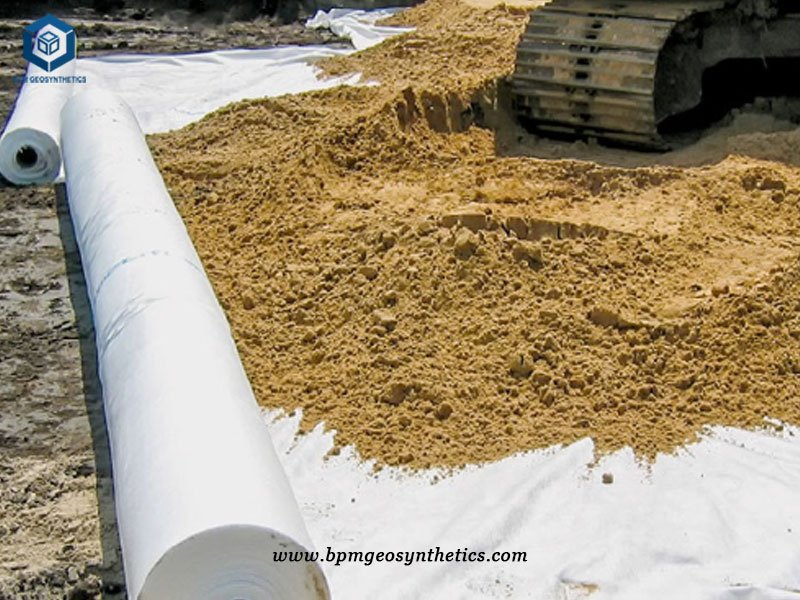
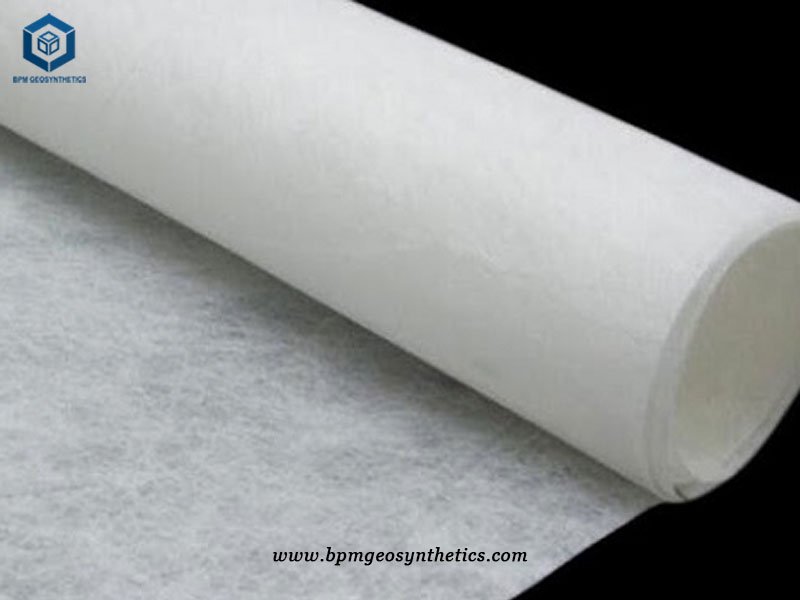
5 Benefits of Non-woven PET Geotextile Layer
The non-woven PET filament geotextile layer offers several benefits in geotechnical applications. Let’s explore them in more detail:
1. Excellent Hydraulic Performance: The thickness of the non-woven PET filament geotextile layer ensures a three-dimensional void ratio, which contributes to the establishment of excellent hydraulic performance indicators. This means that water can pass through the geotextile layer efficiently, allowing for proper drainage and preventing water buildup.
2. High Bursting Strength: The bursting strength of the non-woven PET filament geotextile layer is a significant advantage, particularly in applications such as retaining walls and roadbed reinforcement. The geotextile layer can withstand high pressure and stress, providing structural stability and preventing failure or collapse.
3. Superior Tensile Strength: The tensile index values of the non-woven PET filament geotextile layer surpass industry standards. This indicates that the geotextile layer has excellent tensile strength, making it a reliable material for geotechnical reinforcement. It can withstand heavy loads, distribute stresses, and enhance the overall strength and stability of the construction.
4. Standardized Production Process: The production process of non-woven PET filament geotextiles has been standardized, ensuring consistent quality and performance. This standardization allows for reliable and predictable results in road construction and other geotechnical applications.
5. Demonstrated Competitiveness: Non-woven PET filament geotextiles of various specifications have been widely adopted in the construction of asphalt highways and asphalt pavement repairs. Their technical and economic efficiency has been demonstrated, showcasing their competitiveness as a geotechnical reinforcement solution.
The non-woven PET filament geotextile layer offers benefits such as excellent hydraulic performance, high bursting strength, superior tensile strength, standardized production processes, and proven competitiveness in road construction and geotechnical applications. These advantages contribute to the reliability, durability, and cost-effectiveness of projects where non-woven PET filament geotextiles are utilized.
6 Laying Method of Non Woven Pet Geotextile Layer
- Use manual rolling; the surface of the fabric should be leveled, and a moderate allowance for deformation processing should be left.
- The laying of long-filament or short-filament geotextiles generally adopts lap joints, stitching and welding. The width of stitching and welding is generally more than 0.1m, and the lap width is generally more than 0.2m. Geotextiles that may be exposed for a long time should be welded or stitched.
From the above overall view, the application of filament geotextiles in high speed has been well promoted, which in turn provides a good guarantee for saving project costs and improving the service life of the project.
7 Summary
Non-woven PET filament geotextile layer has played an important role in providing working solutions for the construction or improvement of secondary unpaved roads, haulage roads, access roads and roads in developing areas. In most cases, geotextiles are placed between soft, fine-grained subgrade soils with sand or stone aggregates on top. Beginning in the 1970s, acceptance of this particular application led to a massive increase in the use of geotextiles. Based on field measurements of embankment stability (e.g., from California bearing ratio, shear strength, or modulus of elasticity tests, etc.), relatively simple calculations of the reduction in aggregate thickness required often indicate net cost savings from the use of geotextiles. Additionally, the separation feature of the non-woven PET filament geotextile prevents aggregate from mixing into the underlying subgrade, improving long-term performance.
Non-woven PET filament geotextile layer is one of the fastest growing sectors in the technical textiles market and is expected to maintain growth in the future. Synthetic fibers dominate the woven geotextiles market, but the use of natural fibers cannot be ignored, especially in developing countries. In addition, the standardization of certain properties and test methods will provide more reliable technical data and design methods for geotextiles. This will eventually lead to the design of geotextiles through the “design by function” route. As a result, the geotextile will more effectively perform its stated function over the life of the project. The combination of geotextile mechanics and soil mechanics can effectively solve countless construction and design problems.
Geotextiles are further divided into woven geotextiles and non-woven geotextiles. The former is woven from monofilaments or multi-strands, or woven from flat filaments cut into films; Formed into a mat, and then mechanically entangled or thermally bonded, or chemically bonded.
Non-woven PET filament geotextile layer can replace traditional engineering materials and construction methods, the construction is safer, and it contributes to environmental protection. It can solve basic problems in engineering construction more economically, effectively and permanently. Filament geotextiles have good Excellent mechanical function, good water permeability, anti-corrosion, anti-aging, has the functions of isolation, reverse filtration, drainage, protection, stabilization, reinforcement, etc. The non woven geotextile layer can adapt to uneven base, resist construction external force damage, small creep. The original function of the pavement can still be maintained under long-term load.
The non-woven PET filament geotextile is thicker, which can ensure the three-dimensional void ratio of the non-woven PET filament geotextile, which is conducive to the realization of excellent hydraulic performance; its bursting strength has great advantages, especially suitable for retaining walls and embankment reinforcement. The indicators of non-woven PET filament geotechnical pull force all exceed the standard, and it is an excellent geotechnical reinforcement material.
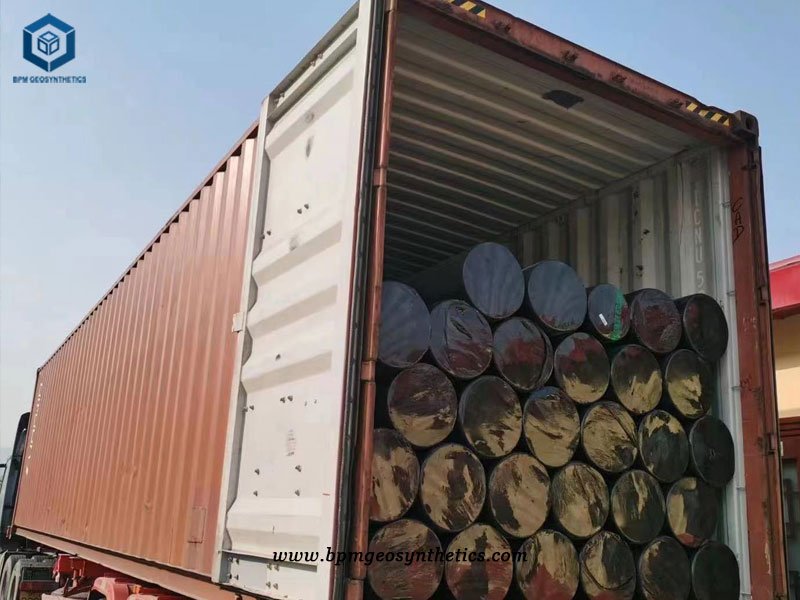
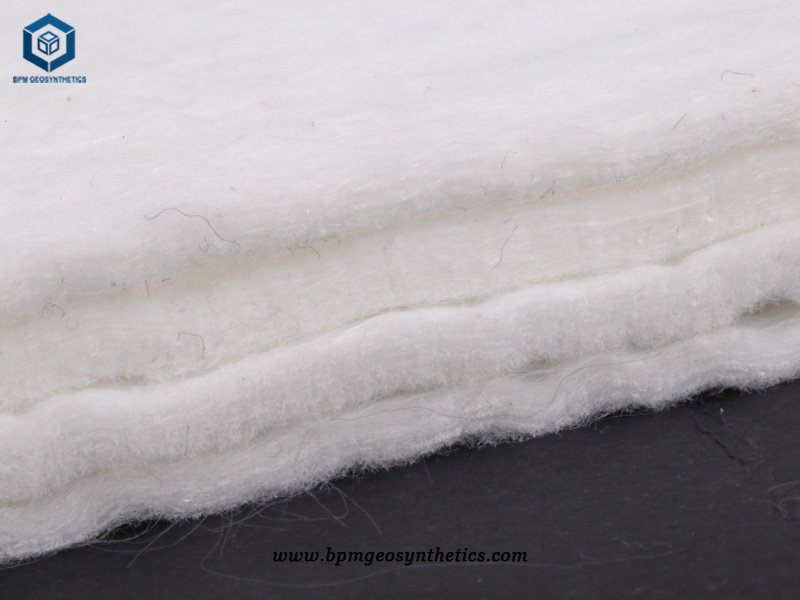
About BPM Geosynthetics
BPM has been specializing in delivering one stop geosynthetics products and solutions to worldwide customers since its foundation in 2007. BPM had provided many types of effective and state of the art geomembranes, geotextiles, geocells, geosynthetic clay liners (GCLs), drainage boards, geogrids to over 81 countries.
BPM is not only manufacturing best quality geosynthetic products but also providing professional design and installation service. OEM, ODM, custom development and fabrication are also available. If you have any questions or inquiries, please contact us, we will reply as soon as possible.


